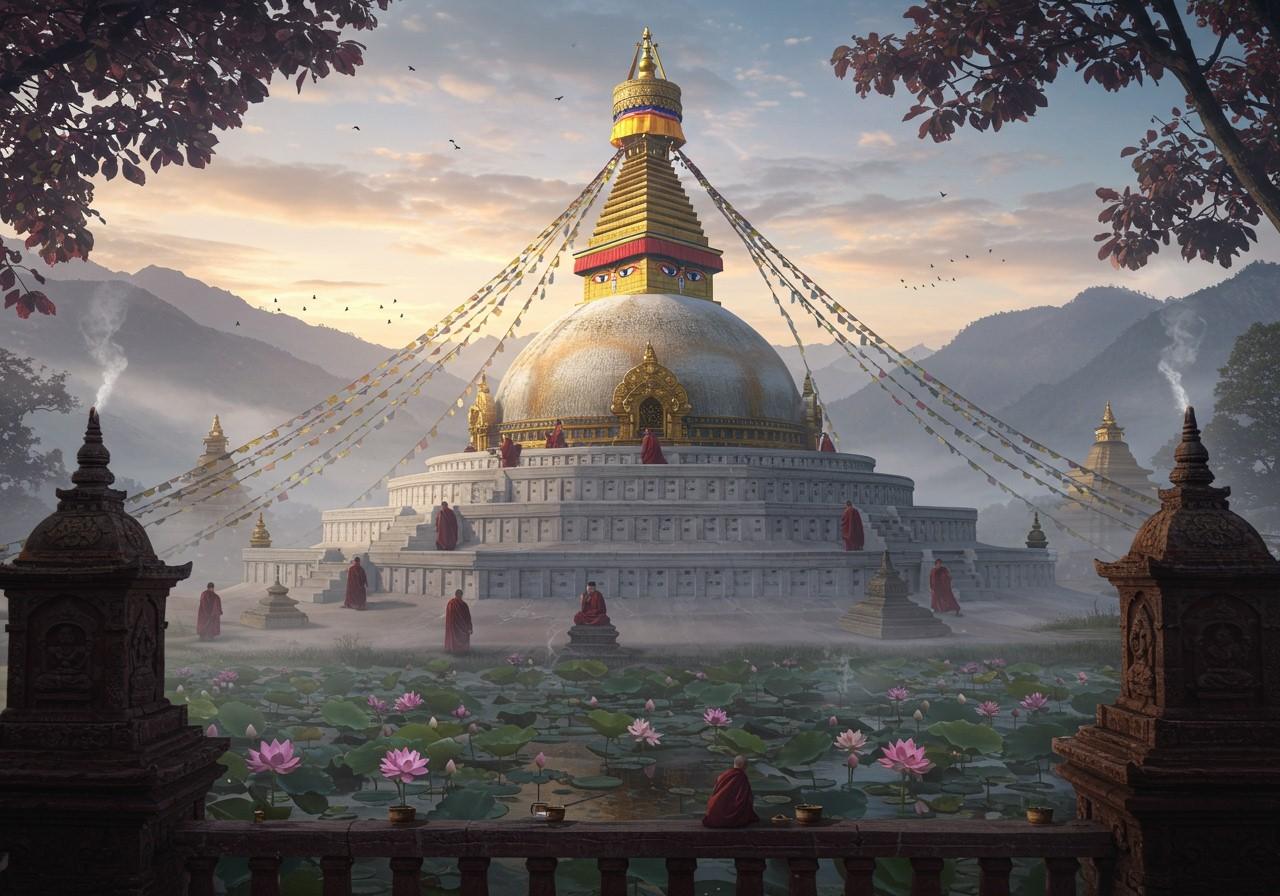
India holds a vast collection of Buddhist heritage sites, many of which remain hidden from the mainstream. These lesser-known gems offer a unique glimpse into the rich tapestry of Buddhism in India. This article delves into three such stupas—Kesariya, Bharhut, and Piprahwa—each possessing unique historical and cultural significance. Understanding these sites not only enhances our appreciation of Buddhist architecture but also connects us to India’s vibrant spiritual past.
Kesariya Stupa: A Majestic Monument in Bihar
Located in the East Champaran district of Bihar, Kesariya Stupa stands as one of the world’s tallest and largest stupas. Dating back to the Mauryan period, it is believed to have been commissioned by Emperor Ashoka. Its architectural grandeur is captivating, featuring a massive cylindrical structure and six terraces. This stupa is thought to mark the very spot where Buddha delivered his final sermon before attaining Nirvana.
British archaeologists began excavating Kesariya Stupa in the early 19th century. The intricate sculptures and reliefs adorning the stupa depict Jataka tales and scenes from Buddha’s life, adding to its historical richness. Kesariya Stupa played a pivotal role in disseminating Buddhism in the region, influencing subsequent Buddhist architecture. Ongoing preservation efforts aim to protect this invaluable heritage site. A visit to Kesariya Stupa is essential for anyone interested in Buddhist heritage and Indian history.
Bharhut Stupa: An Artistic Marvel of the Sunga Dynasty
Situated in Madhya Pradesh, Bharhut Stupa is renowned for its elaborate and detailed relief sculptures. Constructed during the Sunga period in the 2nd century BCE, it provides invaluable insights into early Buddhist art and iconography. The stupa features a circular drum and railings adorned with narrative panels, each telling a story.
The sculptures depict themes such as the life of Buddha, Jataka tales, and various Buddhist symbols. Alexander Cunningham discovered and excavated Bharhut Stupa in the 19th century, with many artifacts subsequently relocated to museums. Inscriptions found at the site offer information about donors and the historical context, further enriching our understanding. Bharhut Stupa’s artistic style significantly influenced later Buddhist monuments like Sanchi and Amaravati. Despite preservation challenges, ongoing conservation efforts strive to protect this artistic marvel.
Piprahwa Stupa: A Link to Buddha’s Relics
Located in Uttar Pradesh’s Siddharthnagar district, Piprahwa Stupa is believed to be among the earliest stupas containing relics of Buddha. Associated with the ancient city of Kapilavastu, Buddha’s birthplace, it dates back to the 3rd century BCE and is linked to the Shakya clan. This connection to Buddha’s origins makes it a particularly significant site for Buddhist pilgrims.
British archaeologist William Claxton Peppe discovered Piprahwa Stupa in 1898, unearthing a soapstone casket containing relics and inscriptions. The stupa’s architectural features include a hemispherical dome and surrounding relic chambers. Inscriptions at the site detail the distribution of Buddha’s relics among various clans, offering a glimpse into early Buddhist practices. Piprahwa Stupa helps us comprehend the early spread of Buddhism and the veneration of relics, and ongoing archaeological research continues to yield new discoveries. Visiting Piprahwa Stupa connects us to India’s spiritual heritage and provides insights into ancient traditions that continue to inspire.
How Poojn.in Enhances Your Buddhist Heritage Journey
Poojn.in offers a curated selection of items for Buddhist rituals and meditation practices, perfect for enhancing your visits to these lesser-known stupas. Whether you’re seeking traditional ceremonial items, natural products for healing, or décor for your home shrine, Poojn.in provides authentic and high-quality options delivered right to your doorstep.
- Chamar Chanvara (Chawar) with German Silver Handle: This traditional ceremonial item is ideal for use during Buddhist ceremonies, adding a touch of authenticity to your practice. Explore ceremonial items at Poojn.in.
- Bamboo Chalon (Circular Tray): Create an authentic space for offerings and ritual items in your personal shrine or meditation area with this beautiful bamboo tray. Find more at Poojn.in
- Natural Products: Chirayta and Arjun Chal powder, available on Poojn.in, connect you to Buddhist healing traditions. Incorporate these natural elements into your wellness practices.
- Pure Sandalwood: A significant element in Buddhist practices, Poojn.in offers guaranteed authentic sandalwood for rituals and meditation, ensuring the purity of your ceremonies. Find authentic sandalwood at Poojn.in
- Home Shrine Décor: Create a serene and inspiring home shrine reminiscent of your stupa visits with Poojn.in’s carefully selected decorative items. Maintain traditional authenticity while adding a personal touch to your sacred space.
Shop Buddhist Ritual Items at Poojn.in and enhance your spiritual practices with certified authentic materials. Each product comes with detailed descriptions and usage guidelines to maintain proper ritual practices.
Conclusion: Discovering India’s Hidden Buddhist Treasures
Exploring lesser-known stupas like Kesariya, Bharhut, and Piprahwa offers a captivating journey into India’s rich Buddhist heritage. These ancient monuments showcase architectural brilliance and offer deep insights into Buddhist history, art, and culture. Visiting these stupas allows us to connect with Buddhism’s spiritual legacy and appreciate the timeless traditions shaping our heritage.
Each stupa narrates a unique story, from Kesariya’s majestic grandeur to Bharhut’s artistic marvels and Piprahwa’s sacred relics. As we continue to uncover and preserve these hidden treasures, we honor Buddha’s wisdom and his teachings’ enduring impact. Embrace the opportunity to explore these remarkable sites and experience the profound heritage that continues to inspire and enrich our lives.
Remember, the journey to these stupas is more than a travel experience; it’s a pilgrimage to the heart of India’s spiritual and historical essence.
Frequently Asked Questions about Lesser-Known Stupas
What distinguishes Kesariya Stupa? Kesariya Stupa, located in Bihar, is one of the world’s largest, believed to be commissioned by Emperor Ashoka.
Where is Bharhut Stupa situated? Bharhut Stupa, renowned for its intricate carvings, is located in Madhya Pradesh.
What makes Piprahwa Stupa unique? Piprahwa Stupa, in Uttar Pradesh, is believed to contain relics of Buddha, linking it to his birthplace.
Are these stupas easily accessible? Most are accessible, though some may require prior permissions or guided tours.
Why are these stupas lesser-known? They haven’t received the same level of publicity as major sites like Sanchi or Bodh Gaya, keeping them hidden from mainstream tourism.
What is Bharhut Stupa’s historical significance? Its ancient carvings, depicting Buddhist tales and teachings, contribute significantly to our understanding of early Buddhist art.
Is there an entry fee for Kesariya Stupa? Usually a nominal fee applies, but it’s best to confirm locally.
Are guided tours available? Yes, guided tours are available for most of these stupas, offering valuable insights.


